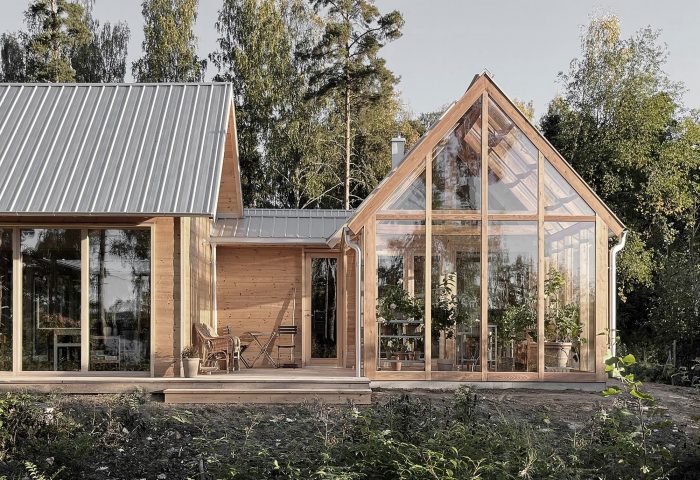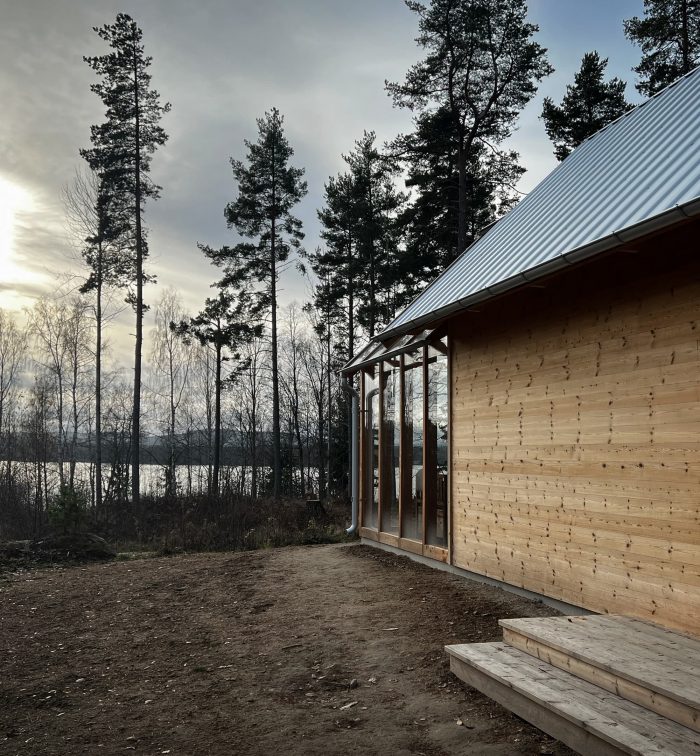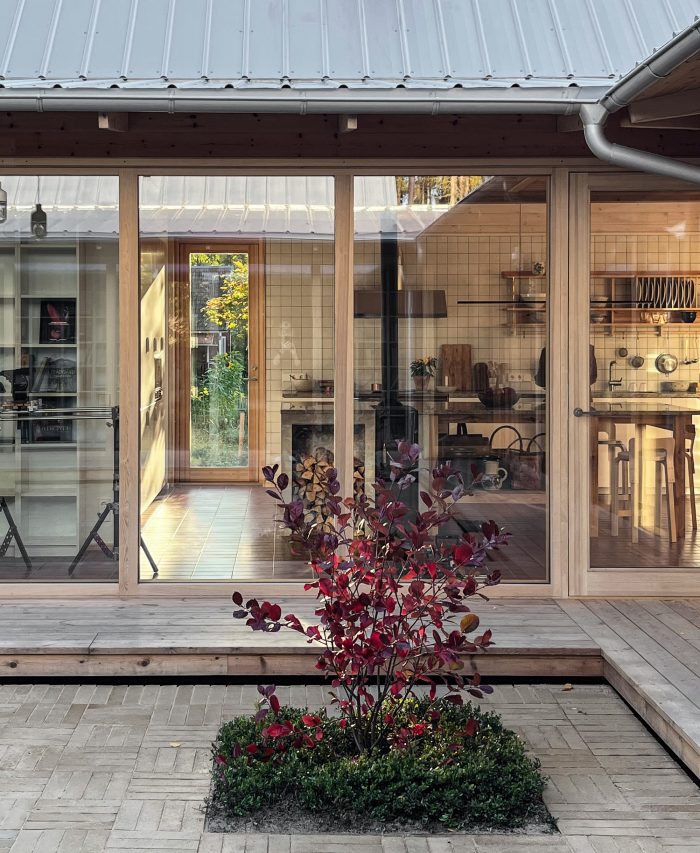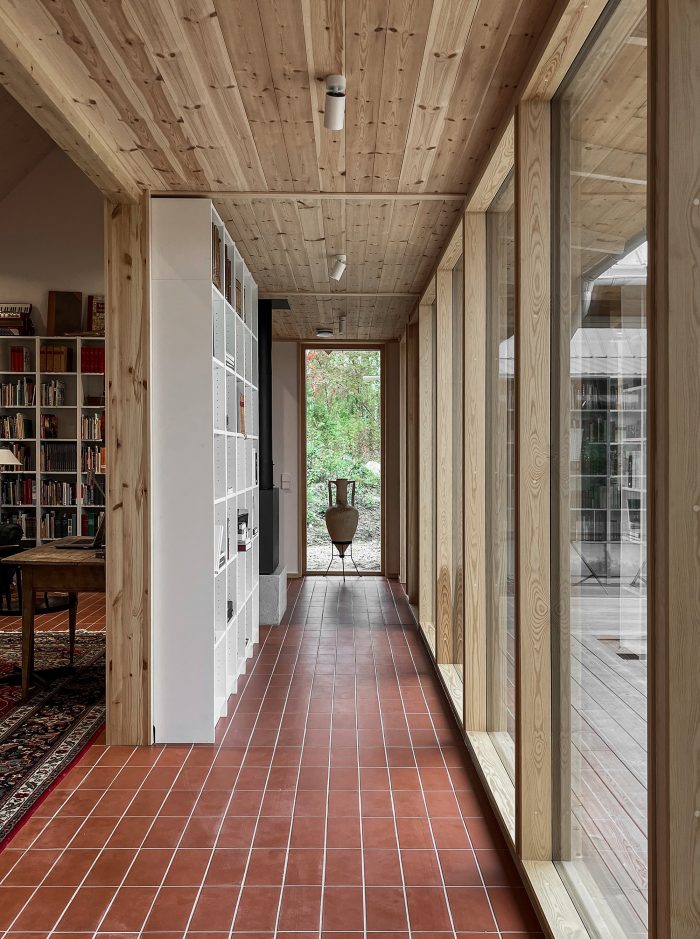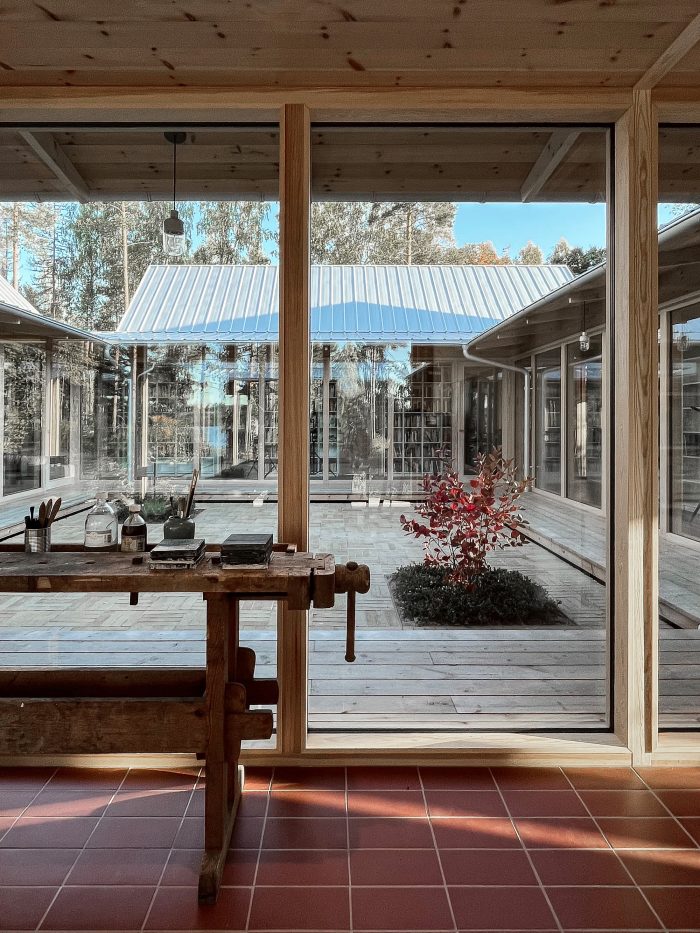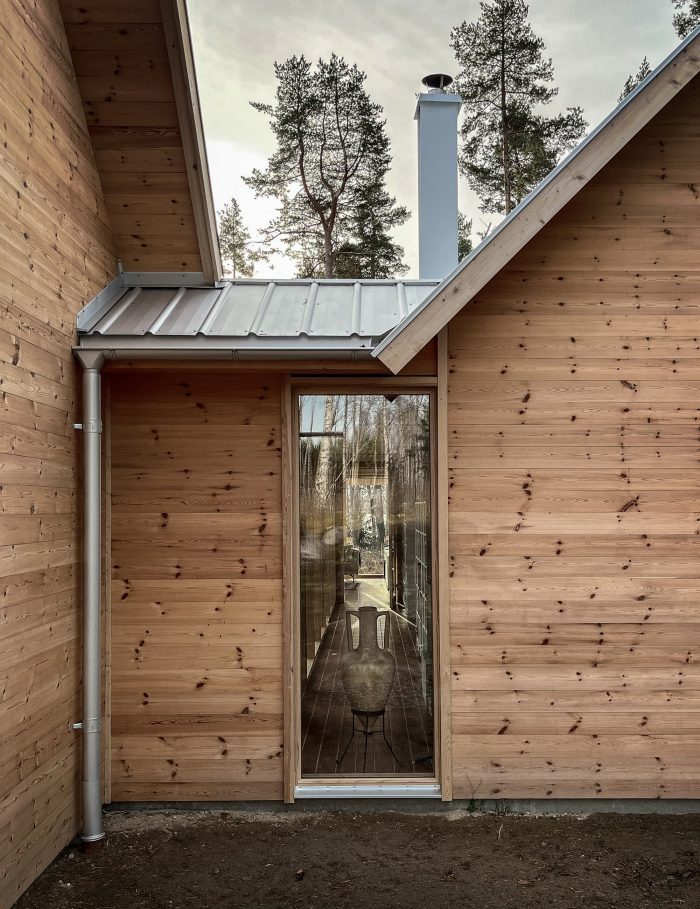图书馆之家 “的设计是为了满足一位陶艺家和一位律师的要求,他们需要一个能够容纳他们大量藏书的房子,并为他们提供工作和创造性活动的空间。
Library House was designed to meet the requirements of a ceramicist and a lawyer in need of a house capable of holding their extensive book collection as well as providing them with spaces for work and creative activity.
这对夫妇有不同的需求和节奏,同时又喜欢对方的陪伴和存在–他们希望有一所房子,在那里他们可以平静地各自工作,而不完全屏蔽对方。为了回应这些要求,建筑工作室 “Frea Folket “围绕着一个图书馆设计了一栋房子,其形状是一个书库,并有一个小院子。
该房屋位于Voxsjön湖边的一片稀疏的松树林中,紧挨着该家族原来的住宅和花园–Villa Skoghem,一个20世纪初的林务员住宅。北面、东面和西面的外墙与周围环境相当封闭,只有几个精心挑选的观景台,而南面则向湖面开放。
Having different needs and rhythms and at the same time enjoying each other’s company and presence – the couple wanted a house where they could find peace to work individually without entirely screening each other off. Responding to these requests, architectural Studio “Fria Folket” composed a house organized around a library in the shape of a book gallery framing a small courtyard.
The house is situated on the edge of a sparse pine forest by lake Voxsjön, right next to the family ́s original home and garden, Villa Skoghem, a forester ́s residence from the early 20th century. While the north, east and west facades are quite closed to the surroundings with just a few carefully selected outlooks, the south side opens toward the lake.
四座屋檐建筑补充了位于中心位置的图书馆,每座建筑都根据相邻的部分解决自己的具体部分;东楼–烹饪和园艺,南楼–艺术和手工艺,西楼–法律、科学和音乐,北楼则容纳了休息和恢复–冥想和自我发展的区域。图书馆将各卷书联系在一起–从主题上和系统上–作为项目的核心和血脉发挥作用。
Four gable-roof buildings complement the centrally located library, each one solving its own specific part of the program in accordance with the adjoining section; the East building – Cooking and gardening, the South building – Arts and crafts, the West building – Law, science and music and the North building, accommodating the areas for rest and recovery – Meditation and self-development. Linking the volumes together – thematically as well as systematically – the library functions as the core and bloodstream of the project.
四个房子是按照太阳的运动顺序组织的,房子的起点,也就是入口,与一天的起点一致,在东方。通过房子的移动,太阳最终休息,就像房子一样,在北方。
The four houses are organized in the order of the sun’s movement with the starting point of the house, i.e the entrance, in line with the starting point of the day, in the east. Moving through the house the sun finally rests, just like the house, in the north.
私密性的程度也遵循同样的循环。从最大的社交空间、走廊和厨房,到圆圈尽头的最私密的空间。顺时针方向的移动是由窗户的位置来鼓励的,当顺时针方向行走时,窗户提供了对周围环境的看法,而当逆时针方向移动时,则面对封闭的书架墙。
The degree of privacy follows the same loop. From the most social spaces, hallway, and kitchen, to the most private spaces at the end of the circle. The clockwise movement is encouraged by the placement of the windows providing views towards the surroundings when walking clockwise in opposed to facing the closed bookcase walls when moving counterclockwise.
四个门,在书廊的每个角落都有一个,提供了从房子的各个部分进入院子的通道,使人们很容易在内部和外部之间移动。
Four doors, one in each corner of the book gallery, offer access to the courtyard from all parts of the house, making it easy to move between the inside and outside.
除了庭院的玻璃框架的透明度之外,书柜构成的强大的方形边界,放大了图书馆延伸到气候外壳之外的感觉,将庭院规划为一个露天的阅读空间。一个房间是由它的目的而不是它的物理限制来定义的。
考虑到图书馆广泛的色彩范围,室内的材料很少而且很朴素。在白色、刷白的松木和天然松木的金黄色调中,瓷砖地板以其温暖的砖红色脱颖而出。
The strong square-shaped boundary made up of the bookcases in addition to the transparency of the glassed framing of the courtyard, amplifies the perception of the library extending beyond the climate shell, programming the courtyard into an open-air reading space. A room is defined by its purpose rather than its physical limits.
Considering the wide color spectrum of the library the materials of the interior are few and austere. Against the blond palette of white, whitewashed pine, and natural pine, the ceramic tiled floor stands out with its warm brick-red color.
为了追求可持续发展,房子已经根据家庭现有的家具进行了定制,以减少购买新家具和更换的需要。因此,标志性的宜家书柜 “Billy “在决定房子的措施方面发挥了重要作用,它是现有图书馆的持有人。
In pursuit of sustainability, the house has been customized to the families existing furniture in order to reduce the need to buy new and replace. In consequence, the iconic Ikea bookcase” Billy” has played an essential part in determining the measures of the house being the holder of the existing library.
为了进一步减少对环境的影响,墙壁和屋顶的建造不使用塑料,并根据该地区的传统,使用亚麻纤维进行隔热。外墙采用当地锯木厂生产的未经处理的心形松木,无混凝土的泡沫玻璃基础由回收的玻璃制成。屋顶上的雨水被收集到一个地下水箱中,为温室提供水源。
With the further intention of reducing the environmental footprint, the walls and roofs have been constructed free from plastic and insulated with flax fibers according to the vernacular traditions of the area. The facade is clad with untreated heart pine from a local sawmill and the concrete-free foamglass foundation is made from recycled glass. The rainwater from the aluzink-clad roof is collected in an underground tank providing the greenhouse with water.
根据古老的北欧建筑传统,其中一个工作室的构造使其在供暖方面可以与房子的其他部分断开。这就提供了在温度下降时缩小房子的选择。
In line with old Nordic building traditions, one of the studios has been constructed so that it can be disconnected from the rest of the house in regards to heating. This provides the option to downsize the house when the temperature drops.
房子里弥漫着某种节奏感,因为建筑的网格在承重玻璃隔断中得到了衔接,这些玻璃隔断是由当地的窗户木工制造的。就像乐谱上的小节一样,这些柱子将书架分割开来,就像乐谱上的节拍。
A certain sense of rhythm pervades the house as the grid of the construction articulates in the load-bearing glass partitions, manufactured at local window carpentry. Like barlines on a piece of sheet music, the posts divide the bookshelves like beats in a measure.
Architects: Fria Folket
Area : 190 m²
Year : 2022
Lead Architect : Hanna Michelson
City : Stockholm
Country : Sweden


